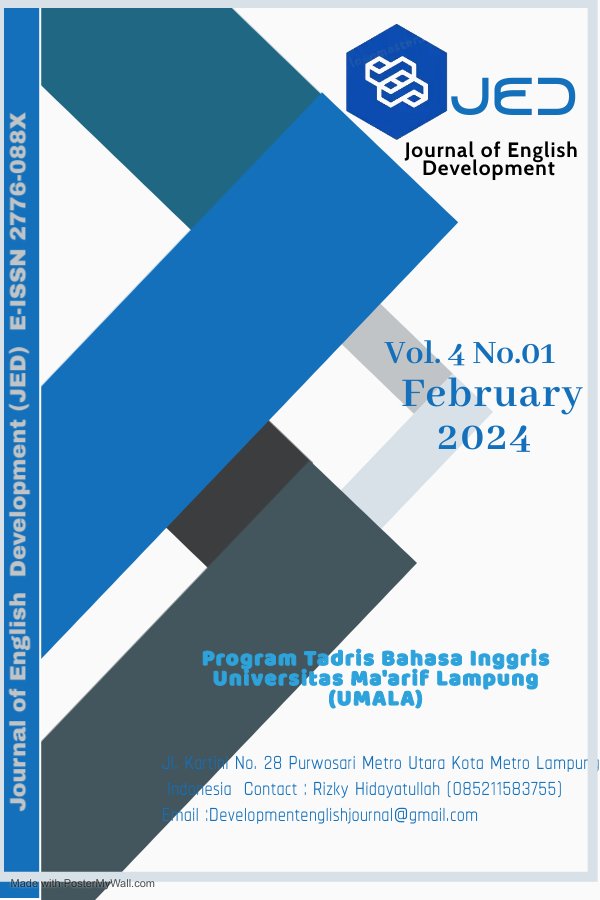Practical Implementation of Pair and Group Works as Communicative Learning Strategies to Increase Students’ HOTS in Speaking Skills
English
DOI:
https://doi.org/10.25217/jed.v4i01.4271Keywords:
Communicative Learning Strategies, Communicative Language Teaching, Higher-Order Thinking Skills (HOTS), Speaking SkillsAbstract
Abstract
Students are needed to learn to effectively speak in English, since it is one of the languages to communicate and intereact in most areas. But as it is foreign language, students may depend on direct instruction than being self-directed learners. Many students have yet to develop their higher-order thinking skills (HOTS), they struggle to think critically and relying more on memorization without a deep understanding especially when they need create produced skills. To handle the situation, this study aimed to increase students’ HOTS in speaking skills. This study was a Classroom Action Research (CAR) with three cycles within three meetings each cycle. There was a class called pre-intermediate that the researcher found most students have LOTS than HOTS. This study used Communicative Learning Strategies to increase students' HOTS in speaking skills by implementing Communicative Language Teaching (CLT) approach and asking them to work in groups and/or pairs. There were 18 participants with whom the researcher implemented the strategies. Data collection used were speaking assessment, observation, questionnaire, and documentation. The findings showed that CLS can increase students' HOTS. The speaking scores have reached the success criteria which are about 4.1 out of 5.0. The results of observation and questionnaires explained that class activities affected their thinking skills, and so did the documentation.
References
REFERENCES
Ahmed, A. (2022). The Effect of Using Communicative language Teaching on EFL Learner’s Speaking skill Developing Pragmatics Competence in Sudanese EFL Learners at Tertiary Level View project. https://www.researchgate.net/publication/359134271
Alrajafi, G. (2021). The Use of English in Indonesia: Status and Influence.
Anderson, L. W., Krathwohl, D. R., Airasian, P. W., Cruikshank, K. A., Mayer, R. E., Pintrich, P. R., Raths, J., & Wittrock, M. C. (2001). A Taxonomy for Learning, Teaching, and Assessing.
Anggraini, A. (2021). Improving Student’s Speaking Skill Using Youtube Video as Media: An Action Research. Scope : Journal of English Language Teaching, 5(2), 57. https://doi.org/10.30998/scope.v5i2.8406
Aziza, N. (2020). The Importance of English Language. www.researchparks.org
Bahruddin, U., & Mochammad Sahid, M. (2020). Implementation of HOTS in Debate Strategy to Improve the Ability of Speaking Arabic among Students. www.solidstatetechnology.us
Kasmaini, Afrilia Wulandari, D., & Damayanti, I. (2021). Improving Students’ Speaking Skills with Action Learning Strategy at Eight Grade of Junior High School. Sastra & Pengajaran, xx No. xx(1). https://doi.org/10.33369/jwacana
Kemmis, S., McTaggart, R., & Nixon, R. (2014). The action research planner: Doing critical participatory action research. In The Action Research Planner: Doing Critical Participatory Action Research. Springer Singapore. https://doi.org/10.1007/978-981-4560-67-2
Oviedo Guado, N. G., & Mena Mayorga, J. I. (2021). Communicative language teaching approach in the development of speaking skill. Ciencia Digital, 5(4), 6–26. https://doi.org/10.33262/cienciadigital.v5i4.1865
Purnama, Y. I., & Nurdianingsih, F. (2019). The Impact of Higher Order Thinking Skills (HOTS) Instructions in Teaching EFL Speaking Skill from the Perspective of Students’ Motivation. Lingua Cultura, 13(4), 313. https://doi.org/10.21512/lc.v13i4.6105
Rasyid, N. I., Atmowardoyo, H., Makassar, U. N., & Rahman, Q. (2021). Teacher’s Understanding and Practice on Implementing Higher Oder Thinking Skills (HOTS) in EFL Classroom. Celebes Journal of Language Studies, 1(1).

Downloads
Published
How to Cite
Issue
Section
License
Copyright (c) 2024 Karina Thohirah, Hanni Yukamana, Santi Mayasari, Santi Mayasari

This work is licensed under a Creative Commons Attribution-ShareAlike 4.0 International License.





